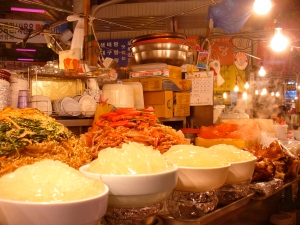Technically, Day 9 is coming to a close on my current abstention from refined sugar and artificial sweetener. This effort is more than a week old, and most would say that the hardest part is over. For me, the initial pangs and cravings aren’t the most difficult aspect of this endeavor. For me, the hardest work will be in keeping it up, maintaining the habit, and resisting the temptations yet to come. In light of that, I thought I’d begin a new blog thread about my experiences. I’d also like to offer information for those who are considering it, whether you suffer from Diabetes or not.
The Drug Your Body Wants
As a species, we’re wired to seek out substances our body needs that are scarce in the natural environment. Salt, fat, and sugar are the three things your brain has a constant BOLO listed for, because, when we were coming along, these were things not regularly in abundance. Now, however, you see all three conveniently grouped together, in a superabundant supply, everywhere you look. This has posed some major problems for our kidneys and liver, our cardiovascular system, and a number of other other vital parts of our physical bodies. The glut is real.
I remember someone telling me that artificial sweetener didn’t harm anyone. I have mixed feelings about that, but they aren’t what you think. Do they cause cancer? Hm. The data to date are inconclusive about that, and human tests are scarce. Do they do other things that we should keep an eye on? Absolutely. One of these is very important, but first, let’s talk about the brain’s reward system.
Every time you press the sugar lever, your brain rewards you by giving you a bump of dopamine, among other things. “Good hairless ape. That’s right. Do your drugs.” 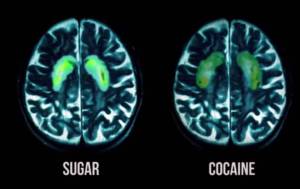 Drugs? Absolutely. Not only is sugar addictive, in part because we are wired to look for it–honey, fruit, some grubs and insects, flowers–but because, in this supersaturated sugar landscape of modern life, we have become dopamine addicts. And those feel-good chemicals made in-house are often stimulated to make up for deficiencies in our emotional and professional lives.
Drugs? Absolutely. Not only is sugar addictive, in part because we are wired to look for it–honey, fruit, some grubs and insects, flowers–but because, in this supersaturated sugar landscape of modern life, we have become dopamine addicts. And those feel-good chemicals made in-house are often stimulated to make up for deficiencies in our emotional and professional lives.
It’s Not Directly About the Insulin
Artificial sweetener does not stimulate your body to dump insulin into your bloodstream. This is a myth. In fact, it doesn’t actually register on your brain’s dopamine dispensary radar. It’s not real. It doesn’t exist in nature. Its sweetness is an illusion. You’d get as much reaction from licking a battery in terms of dopamine and insulin response. What it does do is much worse than the myth, at least from my perspective.
You eat these foods–which are nutrient deserts in your mouth–lots of flavor, but very little in the way of actual substance, since sugar free, fat free, and reduced calorie tend to flock together. Your brain feels cheated, and gives you very little in the way of reimbursement for that Diet Coke. The drug addict just under the surface of your consciousness starts hurting for it. It needs its fix. Wasn’t sugary sweetness just here…?
WHERE’S MY DRUG!?! I WANT MY DRUG! YOU LIED TO ME!

Cue hunger, even if you just think you ate a snacky cake/diet snack/fat-free sugar-free chemical cookie. You will respond to it. You will heed it. Your will is nothing in the face of this. So you eat. And eat. And eat. And until you consume the right food that your inner drug addict wants, you’ll still be hungry. Lest you assume that this is simple appetite, I can assure you, it’s not.
Your body is waging chemical warfare on you as revenge for the fact that you’ve cheated it and fed it a nutrient vacuum. By the time a Diabetic has hit the appropriate lever in the fridge, at the drive-thru, in the grocery store parking lot, they’ve been driven into a semi-hysterical fury and mistakes have been made. Your body is now sated, but it took you 3,500 calories to feed it the thing it wanted. That’s one of the big reasons I stay away from artificial sweets–the other has to do with gut flora, but that’s another story for another day.
Diabetic Relativity and Sugar
People who don’t have issues with insulin production or receptivity–type I and II Diabetes–will simply have to shoulder through the first couple of weeks and tough it out. No big deal, apart from the psychological and physical freak show that the cravings will make of them occasionally. However, if you’re like me–type II–there are a few additional things to be kept firmly in mind.
First, everyone and their other brother Daryl think that all Diabetes are the same. They aren’t. 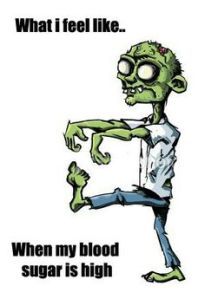 Even within a type group, there’s a lot of variation and wiggle room. For instance, when you have uncontrolled Type II, “low” blood sugar is incredibly relative, because your body has gotten used to dealing with insane blood glucose levels all the time. For example:
Even within a type group, there’s a lot of variation and wiggle room. For instance, when you have uncontrolled Type II, “low” blood sugar is incredibly relative, because your body has gotten used to dealing with insane blood glucose levels all the time. For example:
Let’s say your fasting level is 140, the norm being around 70. You eat, it spikes and comes down a bit, but is still over 200 for your 2-hour reading, when the norm is generally between 100-120. For your body, that’s become “normal.” If your blood sugar troughs and you feel like death warmed over, with all the horror story symptoms of low blood glucose, it could still read around 100. That doesn’t change how it feels.
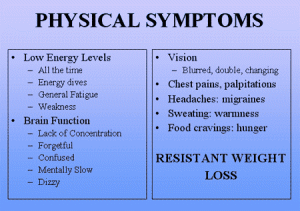 You see, Diabetes is something your body works around. That doesn’t mean you’re healthy, but your body’s job is to keep you moving around, even if it has to do some serious duct tape and zip ties to get it done. While you’re still walking around eating ho-dinkies and guzzling Coca-Cola, your body is falling apart. You feel a bit unwell, but you push through. It’s nothing compared to the agony of deprivation that a diet represents, you rationalize. Please stop lying to yourselves. I know what you’re doing. I did it for years.
You see, Diabetes is something your body works around. That doesn’t mean you’re healthy, but your body’s job is to keep you moving around, even if it has to do some serious duct tape and zip ties to get it done. While you’re still walking around eating ho-dinkies and guzzling Coca-Cola, your body is falling apart. You feel a bit unwell, but you push through. It’s nothing compared to the agony of deprivation that a diet represents, you rationalize. Please stop lying to yourselves. I know what you’re doing. I did it for years.
When you decide it’s time to take your destiny in hand and abandon the Good Ship Lollypop like a fucking plague rat, here are a few things to keep in mind. I can only speak from experience of Type II. Type I individuals should follow what they know about their needs and the requirements of insulin dependent diabetes.
- Watch your blood glucose levels like a hawk. Part of Type II is glucose instability, not just a really high number.
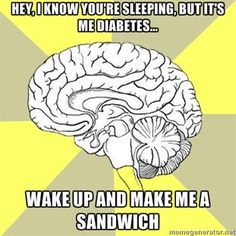 When you eschew the sugar teat, you’re going to feel it. The first time I did this, I lived alone. Waking and not knowing why, feeling the world was caving in on me and having to crawl into the kitchen because I couldn’t stand was terrifying. My blood glucose levels tested around 40, and that was immediately after I sucked down some honey. So, keep glucose tabs or a honey bear handy. Keep your test supplies easy to hand and get into the habit of testing more often.
When you eschew the sugar teat, you’re going to feel it. The first time I did this, I lived alone. Waking and not knowing why, feeling the world was caving in on me and having to crawl into the kitchen because I couldn’t stand was terrifying. My blood glucose levels tested around 40, and that was immediately after I sucked down some honey. So, keep glucose tabs or a honey bear handy. Keep your test supplies easy to hand and get into the habit of testing more often. - Keep a record, along with your levels, the time you tested, what you’re eating, and how you feel. Trust me, it seems like a pain in the ass, but this log will be your best friend when it comes to assessing what’s working and what isn’t. It will also help you to identify potential foods that you should avoid or eat more of, based on these records. There’s all manner of processed foods that are full of high fructose corn syrup–like pizza, packaged bread, or sliced meat. Get a nasty spike from that sandwich? Look at the ingredients and figure out why.
- Exercise. Anything more than you normally do, even an extra flight of stairs or walking the dog to the mailbox, is better than doing nothing. Start small, keep it manageable, but do it every day. Every. Damned. Day. And add intensity or duration as you become used to it. This, believe it or not, is one of the big things that I noticed helped me to stabilize my glucose levels relatively quickly. I still had highs and lows, but they were nowhere near as extreme, and I often tested in the range of Normal People after a while.
- Keep snacks handy, but try to avoid processed foods, if possible. Some good things that I found worked for me where:
- Tree nuts or peanuts
- Wasabe peas
- Unhulled, roasted pumpkin seeds
- Sunflower seeds
- Berries
- Melon cubes
- Apples, pears, oranges, and ruby red grapefruits (seasonally)
- Peanut butter
- Carrot and celery sticks, kept in a mug of water in the fridge
- Hummus (I like roasted garlic or super spicy, but there are other flavors.)
- Blue corn chips or any that are less processed
- Falafel chips (a little pricy, but a few will do for a snack.)
- Chicken salad (made at home, prepped and ready to be eaten on a whim)
- Raw honey (for emergencies)
Now this is by no means a comprehensive list, nor is it intended to be a dictate. You should find the best snacks for your budget, needs, and preferences. But do try to skew towards the less processed whole foods, as opposed to pre-packaged snacks. What matters is ready availability of snackage, because you are going to feel like someone scooped out your innards with a spoon–hollow as a pinata, and ravenous nearly all the time at first. This is your body screaming for its drug.
Try to be strong, and monitor your glucose levels carefully. Pace yourself when snacking, so you don’t eat 3,000 calories of healthy snacks. That’s not healthy, and your blood sugar will spike. Another reason to watch your levels is that your liver stores reserves of sugar that your body wouldn’t process as glycogen. For those with advanced and untreated diabetes, your liver also looks like fois gras–full of fatty inclusions, precisely because of all that sugar. As you clean up your diet, your liver is going to dump those reserves faster than China in a fit of pique can dump their U.S. Dollars. It’s ultimately a good thing, but the process itself makes for a bit of a glucose roller coaster at times.
Alright. I think that’s more than enough for now. I’ll be back another night, chattering about my experience with this particular sugar cleanse.


